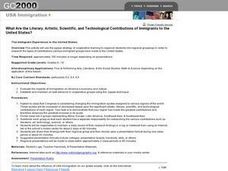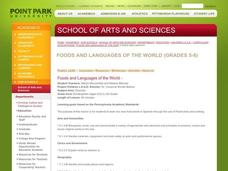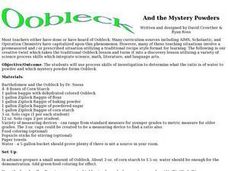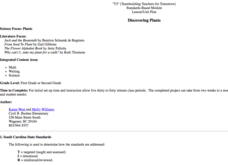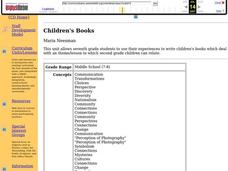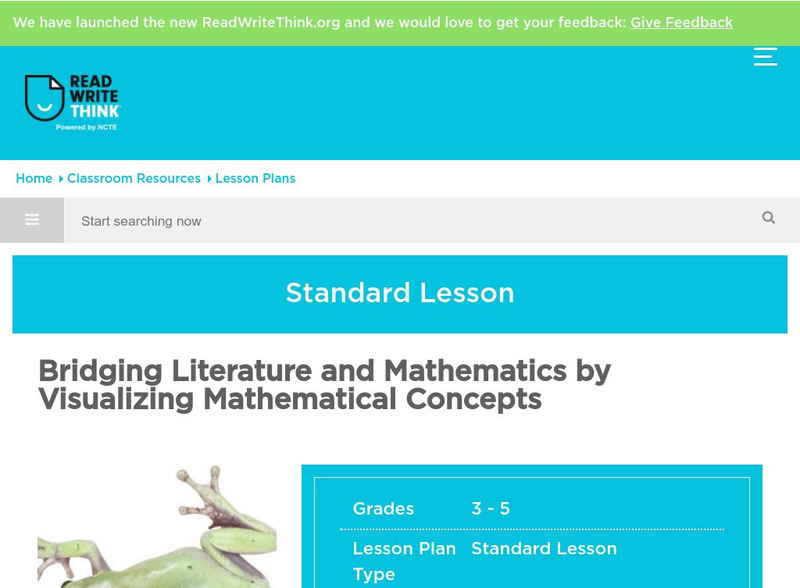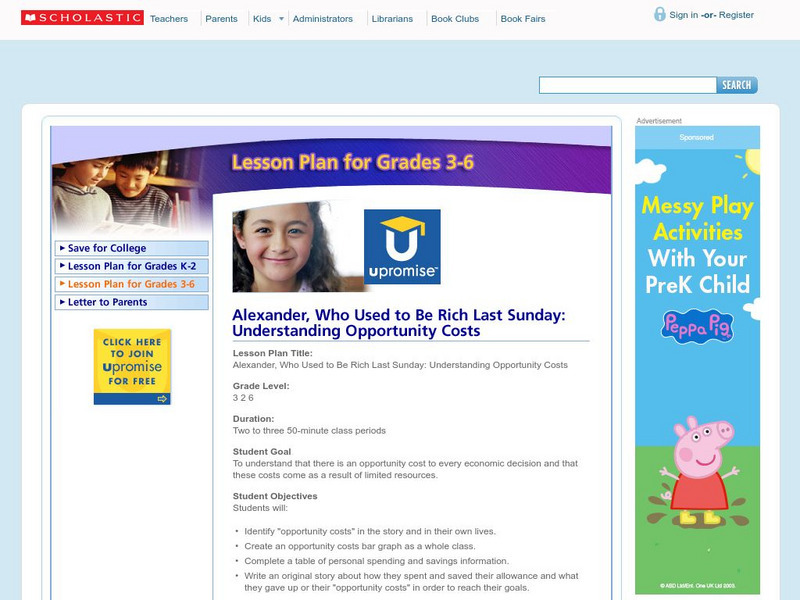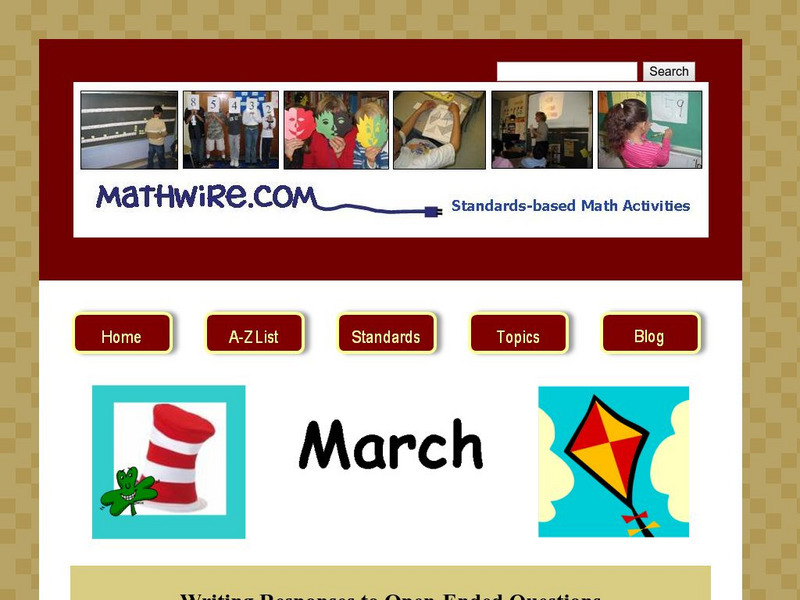Curated OER
What Are the Literary, Artistic, Scientific, and Technological Contributions of Immigrants to the United States?
Students evaluate impact of immigration on America's economy and culture, research information about people of various countries of origin, and share findings with classmates through collages, posters, handouts, or skits.
Curated OER
All About Me: My Senses
Students explore the world around them and identify their five senses and the parts of their bodies that are associated with each sense.
Curated OER
Cardboard History
Young scholars investigate the history of baseball and create baseball cards based on research they have collected about early baseball players.
Curated OER
Foods and Languages of the World
Young scholars review Mexico's location and language and learn to pronouns 10 new Spanish food words. Students listen as the book, Corn is Maize is read, touching and passing around an ear of Indian corn. Young scholars discuss the...
Curated OER
Smoke and Mirrors
Students develop a persuasive peer-to-peer case against smoking. They read two scenarios, perform a skit, and prepare a factual presentation.
Curated OER
Compound Word Heart Match
Young scholars participate in a matching word parts activity. In this heart activity, students match two sides of a heart to make a compound word. Young scholars match the word the teacher puts on the board. Students complete...
Curated OER
Oobleck and the Mystery Powders
Pupils listen to the book, "Oobleck," by Dr. Suess before experimenting with mystery powders. They determine the proper ratio of powder to liquid to make the Oobleck.
University of Southern California
Discovering Plants
Students construct a small greenhouse and plant lima beans. They read books about plants, tend the lima bean seedlings, observe and record plant growth, taste a variety of plants and maintain plant journals.
Curated OER
Children's Books
Young scholars explore daily dilemmas students face. They write and illustrate a story book dealing with one dilemma. Young scholars write reviews of their books. They read their books to second grade students. Additional cross...
Curated OER
Life in a Cup
Third graders make and maintain a mini terrarium. They keep a daily journal of what happens in their terrarium and record daily observations and measurements.
Curated OER
Plants
Students identify and label parts of a plant. They will construct a plant from art material and describe the purpose of each part for the plants survival. Students author a book with pictures and words or a story about a plant.
Curated OER
Pictures Telling Stories
Students see the importance of primary sources in the study of history, but also the limitations of relying only on primary sources of taking the money, as it were, at face value.
Curated OER
All Aboard!
Sixth graders plan a road trip to a city in the US. They include railroad saftey messages as they write about the trip.
Curated OER
TE Activity: Tears in Rain
Students examine photographs before writing captions for them. They develop visual literacy as they see how photographs are manipulated to show the effects of acid rain. They rewrite the photo captions after a class discussion.
Curated OER
Community Action
Fifth graders brainstorm a list of decisions that students make daily that affect the welfare of the environment categorizing them as being either helpful or harmful. They then trace local actions to distant consequences to determine how...
Curated OER
Enigmas
Students research "mystery" topics such as Easter Island, Bermuda Triangle and the Loch Ness Monster. Students brainstorm mysteries and explore the one of their choosing. They write a short report and share what they have learned with...
ReadWriteThink
Read Write Think: Bridging Literature and Mathematics
Contains plans for five 50-minute interdisciplinary lessons that ask students to write about math-related, informational books such as "Actual Size" (Jenkins, 2004) and "If You Hopped Like a Frog" (Schwartz, 1999). Students use books...
Scholastic
Scholastic Lesson Plan: Alexander, Who Used to Be Rich..
This multipart lesson plan the cost of opportunities when you have limited resources. It uses the hilarious children's book, "Alexander, Who Used to Be Rich Last Sunday" by Judith Viorst to drive the lesson home.
Scholastic
Scholastic Lesson Plan: Simple Ways to Assess Math Sense
This site has two lesson plans are presented by Marilyn Burns and associates that use children's literature to help assess math sense. One lesson plan is for use with primary students while the other is for use with intermediate students.
Other
Math Wire
This is an amazing Math site! The lesson activities are based on constructivist teaching. They are organized by topic, theme, standard, strand, alphabetically, etc. Each month new materials are posted related to season, celebrations, and...
National Council of Teachers of Mathematics
The Math Forum: Making Patterns
Explore the literature connections, online activity, pencil and paper activity, and the manipulative investigation of patterns and geometric shapes on this page!
National Council of Teachers of Mathematics
The Math Forum: Lesson Plan Non Standard Measuring
This is a short, fun lesson plan with a literature connection, "Miss Nelson is Missing". It uses candy bars as non-standard units for measuring objects in the classroom.
National Council of Teachers of Mathematics
The Math Forum: Lesson Plan Non Standard Measuring
This is a short, fun lesson plan with a literature connection, "Miss Nelson is Missing". It uses candy bars as non-standard units for measuring objects in the classroom.
Scholastic
Scholastic Lesson Plan: A Chair for My Mother
This extensive lesson plan uses the Children's Literature book "A Chair for My Mother," by Vera B. Williams to teach the concepts of saving and reaching a goal. Primary students are the target for this lesson.
